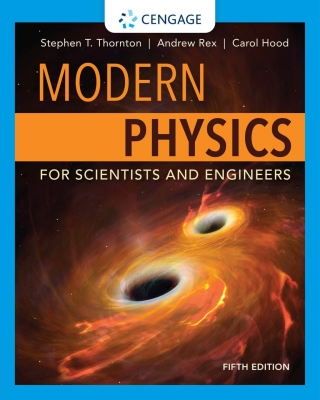Buy Modern Physics for Scientists and Engineers, 5th Edition PDF ebook by author Stephen T. Thornton; Andrew Rex; Carol E. Hood – published by Cengage Learning UK in 2021 and save up to 80% compared to the print version of this textbook. With PDF version of this textbook, not only save you money, you can also highlight, add text, underline add post-it notes, bookmarks to pages, instantly search for the major terms or chapter titles, etc.
You can search our site for other versions of the Modern Physics for Scientists and Engineers, 5th Edition PDF ebook. You can also search for others PDF ebooks from publisher Cengage Learning UK, as well as from your favorite authors. We have thousands of online textbooks and course materials (mostly in PDF) that you can download immediately after purchase.
Note: e-textBooks do not come with access codes, CDs/DVDs, workbooks, and other supplemental items.
eBook Details:
Full title: Modern Physics for Scientists and Engineers, 5th Edition
Edition: 5th
Copyright year: 2021
Publisher: Cengage Learning UK
Author: Stephen T. Thornton; Andrew Rex; Carol E. Hood
ISBN: 9781337919456, 9780357642054
Format: PDF
Description of Modern Physics for Scientists and Engineers, 5th Edition:
Learn how your life connects to the latest discoveries in physics with MODERN PHYSICS FOR SCIENTISTS AND ENGINEERS. This updated fifth edition offers a contemporary, comprehensive approach with a strong emphasis on applications to help you see how concepts in the book relate to the real world. Discussions on the experiments that led to key discoveries illustrate the process behind scientific advances and give you a historical perspective. Included is a thorough treatment of special relativity, an introduction to general relativity, and a solid foundation in quantum theory to help you succeed. An updated WebAssign course features a mobile-friendly ebook and a variety of assignable questions to enhance your learning experience.
WebAssign for MODERN PHYSICS FOR SCIENTISTS AND ENGINEERS helps you prepare for class with confidence. Its online learning platform helps you unlearn common misconceptions, practice and absorb what you learn and begin your path as a future physicist or engineer. Tutorials walk you through concepts when you’re stuck, and instant feedback and grading let you know where you stand–so you can focus your study time and perform better on in-class assignments and prepare for exams. Study smarter with WebAssign!
Table of Contents of Modern Physics for Scientists and Engineers, 5th Edition PDF ebook:
Contents OverviewContentsPrefaceChapter 1: The Birth of Modern Physics1.1: Classical Physics of the 1890s1.2: The Kinetic Theory of Gases1.3: Waves and Particles1.4: Conservation Laws and Fundamental Forces1.5 The Atomic Theory of MatterSummaryChapter 2: Special Theory of Relativity2.1: The Apparent Need for Ether2.2: The Michelson-Morley Experiment2.3: Einstein’s Postulates2.4: The Lorentz Transformation2.5: Time Dilation and Length Contraction2.6: Addition of Velocities2.7: Experimental Verification2.8: Twin Paradox2.9: Spacetime2.10: Doppler Effect2.11: Relativistic Momentum2.12: Relativistic Energy2.13: Computations in Modern Physics2.14: Electromagnetism and RelativitySummaryQuestionsProblemsChapter 3: The Experimental Basis of Quantum Physics3.1: Discovery of the X Ray and the Electron3.2: Determination of Electron Charge3.3: Line Spectra3.4: Quantization3.5: Blackbody Radiation3.6: Photoelectric Effect3.7: X-Ray Production3.8: Compton Effect3.9: Pair Production and AnnihilationSummaryQuestionsProblemsChapter 4: Structure of the Atom4.1: The Atomic Models of Thomson and Rutherford4.2: Rutherford Scattering4.3: The Classical Atomic Model4.4: The Bohr Model of the Hydrogen Atom4.5: Successes and Failures of the Bohr Model4.6: Characteristic X-Ray Spectra and Atomic Number4.7: Atomic Excitation by ElectronsSummaryQuestionsProblemsChapter 5: Wave Properties of Matter and Quantum Mechanics I5.1: X-Ray Scattering5.2: De Broglie Waves5.3: Electron Scattering5.4: Wave Motion5.5: Waves or Particles?5.6: Uncertainty Principle5.7: Probability, Wave Functions, and the Copenhagen Interpretation5.8: Particle in a BoxSummaryQuestionsProblemsChapter 6: Quantum Mechanics II6.1: The Schrödinger Wave Equation6.2: Expectation Values6.3: Infinite Square-Well Potential6.4: Finite Square-Well Potential6.5: Three-Dimensional Infinite-Potential Well6.6: Simple Harmonic Oscillator6.7: Barriers and TunnelingSummaryQuestionsProblemsChapter 7: The Hydrogen Atom7.1: Application of the Schrödinger Equation to the Hydrogen Atom7.2: Solution of the Schrödinger Equation for Hydrogen7.3: Quantum Numbers7.4: Magnetic Effects on Atomic Spectra-The Normal Zeeman Effect7.5: Intrinsic Spin7.6: Energy Levels and Electron ProbabilitiesSummaryQuestionsProblemsChapter 8: Atomic Physics8.1: Atomic Structure and the Periodic Table8.2: Total Angular Momentum8.3: Anomalous Zeeman EffectSummaryQuestionsProblemsChapter 9: Statistical Physics9.1: Historical Overview9.2: Maxwell Velocity Distribution9.3: Equipartition Theorem9.4: Maxwell Speed Distribution9.5: Classical and Quantum Statistics9.6: Fermi-Dirac Statistics9.7: Bose-Einstein StatisticsSummaryQuestionsProblemsChapter 10: Molecules and Solids10.1: Molecular Bonding and Spectra10.2: Stimulated Emission and Lasers10.3: Structural Properties of Solids10.4: Thermal and Magnetic Properties of Solids10.5: Superconductivity10.6: Applications of SuperconductivitySummaryQuestionsProblemsChapter 11: Semiconductor Theory and Devices11.1: Band Theory of Solids11.2: Semiconductor Theory11.3: Semiconductor Devices11.4: NanotechnologySummaryQuestionsProblemsChapter 12: The Atomic Nucleus12.1: Discovery of the Neutron12.2: Nuclear Properties12.3: The Deuteron12.4: Nuclear Forces12.5: Nuclear Stability12.6: Radioactive Decay12.7: Alpha, Beta, and Gamma Decay12.8: Radioactive NuclidesSummaryQuestionsProblemsChapter 13: Nuclear Interactions and Applications13.1: Nuclear Reactions13.2: Reaction Kinematics13.3: Reaction Mechanisms13.4: Fission13.5: Fission Reactors13.6: Fusion13.7: Special ApplicationsSummaryQuestionsProblemsChapter 14: Particle Physics14.1: Early Discoveries14.2: The Fundamental Interactions14.3: Classification of Particles14.4: Conservation Laws and Symmetries14.5: Quarks14.6: The Families of Matter14.7: Beyond the Standard Model14.8: AcceleratorsSummaryQuestionsProblemsChapter 15: Modern Astrophysics and General Relativity15.1: Stellar Evolution15.2: Galaxies and the Discovery of Dark Matter15.3: Tenets of General Relativity15.4: Tests of General Relativity15.5: Black Holes15.6: Gravitational WavesSummaryQuestionsProblemsChapter 16: Cosmology-The Beginning and the End16.1: Evidence of the Big Bang16.2: The Theory of the Big Bang16.4: The Age of the Universe16.5: The Standard Model of Cosmology16.6: The FutureSummaryQuestionsProblemsAppendix 1: Fundamental ConstantsAppendix 2: Conversion FactorsAppendix 3: Mathematical RelationsAppendix 4: Periodic Table of the ElementsAppendix 5: Atomic Mass TableAppendix 6: Nobel Laureates in PhysicsAppendix 7: Fundamental and Combination of Constants; Particle Masses; Conversion FactorsAppendix 8: The Greek Alphabet; Some Prefixes for the Powers of TenAppendix 9: Emission SpectraAnswers to Selected Odd-Numbered ProblemsIndex





